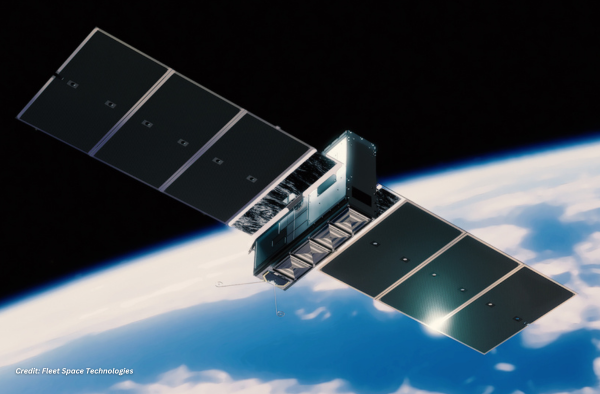Fleet Space demonstrates push-to-talk technology
Share

Fleet Space and SmartSat collaboration results in a significant advancement in tactical communication capabilities.
SmartSat Cooperative Research Centre (SmartSat) today commended Fleet Space Technologies’ successful demonstration of satellite-enabled Push-to-Talk (PTT) capabilities as part of the Defence Space Command-funded ASCEND2LEO project.
SmartSat and Safety from Space supported Fleet Space by adapting a variant of the ‘Beagle’ communications waveform, developed under previously SmartSat-funded projects, which Fleet Space implemented on the Centauri-4 satellite for this demonstration. This milestone in PTT capabilities opens a path to more secure, reliable, instantaneous communications across vast distances using highly advanced microsatellite architectures.
ASCEND2LEO’s successful demonstration for the Australian Defence Force Joint Capabilities Group showed that Fleet Space’s Centauri satellites can be re-programmed to deliver high-quality, fit-for-purpose voice capabilities while in orbit. Voice capabilities for Fleet Space’s Centauri satellite were enabled via a software update, establishing a proof of concept for the regenerative voice system architecture underlying the ASCEND2LEO program. In the end, this demonstration proved that highly flexible microsatellite constellations can quickly provide high-quality, purpose-built SATCOM capabilities at scale to meet complex needs in a wide range of situations.
ASCEND2LEO’s achievement was commended by Peter Kerr, SmartSat’s Defence and National Security Coordinator, who drove the concept for SmartSat’s involvement in the project by adapting and delivering the Beagle waveform.
“Enabling an entirely new voice capability for a satellite that is already in orbit is a tremendous technical accomplishment. With this proof of concept, SmartSat is playing a critical role in helping the Australian industry develop SATCOM resiliency for Australian defence and validate the Regenerative Voice System architecture, a powerful and ambitious approach undertaken by the ASCEND2LEO programme.”
During the live demonstration, hosted by the Defence Science & Technology Group (DSTG), Fleet Space’s PTT capabilities met strict performance criteria for one-way voice transmission, including voice quality, reliability, and link persistence across thousands of kilometres in manifold operational environments. With the successful demonstration of this technology, Fleet Space has shown the ability of its satellites to support critical missions and enable the development of a resilient space infrastructure for Australia and its allies around the world.
“Our demonstration of PTT for the ASCEND2LEO programme is the latest example of Fleet Space’s commitment to pushing the boundaries of innovation to meet the rapidly evolving and complex needs of the Australian Defence Force,” said Matt Pearson, Co-Founder and Chief Exploration Officer at Fleet Space. “By successfully delivering a software update to our Centauri satellite while in orbit, we are proud to be the developer and operator of the world’s smallest known voice-enabled satellite, creating new innovation pathways to advance new capabilities for the global space industry and beyond.”
The pivotal ‘Beagle’ waveform technology was first demonstrated in SmartSat’s Resilient Emergency and Search and Rescue Communications project to develop an enhanced emergency safety beacon using next-generation satellites, particularly in remote locations. SmartSat subsequently funded a second project, LunaSAR, focused on emergency communications for astronaut suit telemetry and lunar terrain vehicle telemetry, supporting NASA’s Artemis program. In this third phase, a variant of the Beagle waveform was delivered to Fleet Space for their ASCEND2LEO programme, following the signing of a AU$6.4 million contract with Defence Space Command to deliver tactical voice and data transmission where connectivity is limited.
The SmartSat-led ASCEND2LEO research partnership aims to advance the national space and defence industry by utilising Australia’s competitive strengths. SmartSat facilitated a collaborative effort between Fleet Space and research partners, the University of South Australia, who provided critical infrastructure for ground satellite communications; DSTG, who contributed significant expertise to testing and validating the on-orbit performance of the waveform; and Safety from Space, who contributed the updated waveform and helped with integration onto Fleet’s satellite payload.
This article was also featured on: https://commsroom.co/fleet-space-demonstrates-push-to-talk-technology/
Public Spectrum is the first knowledge-sharing platform in Australia to embrace the entire public sector. This website is a platform where you can connect, collaborate, empower, inspire, and upskill with public sector professionals.


Today’s Pick
11th Annual Aus Goverment Data Summit
April 1, 2025
7th Annual NZ Government Data Summit
May 7, 2025
3rd Public Sector Comms Week
May 14, 2025
Subscribe
We send emails,
but we do not spam
Join our mailing list to be on the front lines of healthcare , get exclusive content, and promos.
AI appointment Australia Australian boost boosts business businesses covid-19 cyber cyber attack cybersecurity cyber security data data breach data management defence Digital employment enhance enhances fraud funding governance government grants infrastructure Innovation Lockdown management new zealand NSW NZ online privacy public Public Sector queensland renewable energy scams security Social Media Technology telecommunications victoria
-

Understanding and building your digital strategy
Digital Government, Opinion
-

Featured Leader: Jamie Morse on multi-channel strategies for communication
Communications, Featured Leader
-

Featured Leader: Tegan Tembe of NSW Treasury on creating solid planning strategies and processes
Featured Leader
-

Wirraka Maya Health Service improves patient care with My Health Record
Learning
Show More-

Effects of ineffective communication in the workplace
Communications, Personal Development
-

7 ways you can enhance your personal development skills
News, Personal Development
-

5 advantages of working in the public sector
News, Personal Development, Professional Development
-

7 causes of communication issues in the workplace
Communications, News, Personal Development
Show MoreLast Viewed